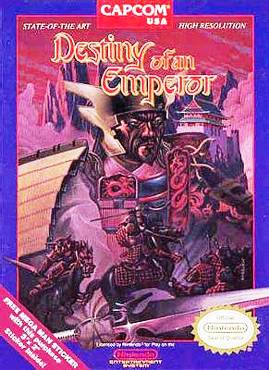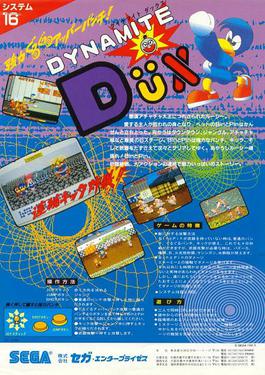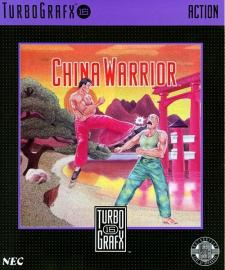| Die Bahnwelt | |
|---|---|
 | |
| Developer(s) | Glodia |
| Publisher(s) | Glodia |
| Platform(s) | Sharp X68000 |
| Release |
|
| Genre(s) | Run and gun |
| Mode(s) | Single-player |
Die Bahnwelt is a multi-directional Run and gun that was released for the Sharp X68000 in 1992 by Glodia. [1]
| Die Bahnwelt | |
|---|---|
 | |
| Developer(s) | Glodia |
| Publisher(s) | Glodia |
| Platform(s) | Sharp X68000 |
| Release |
|
| Genre(s) | Run and gun |
| Mode(s) | Single-player |
Die Bahnwelt is a multi-directional Run and gun that was released for the Sharp X68000 in 1992 by Glodia. [1]


The player directly moves one character in three dimensions in an overhead perspective through science fiction themed dungeons. The player can shoot in eight directions. There are also different second characters that the player can indirectly control through AI. There are multiple weapons that can be collected that can be switched at will. There is a life bar that regenerates if no damage is taken for a period of time. The game has a save system. [2] The game also contains many anime cutscenes. [3] There is an English fan translation available for this game. [4] The game is currently freeware. [5]

Destiny of an Emperor, known in Japan as Tenchi wo Kurau, is a strategy role-playing game by Capcom for the Nintendo Entertainment System based on the Tenchi wo Kurau manga by Hiroshi Motomiya. It was originally released in Japan in 1989, with an English language localization released for the North American market in 1990.
A visual novel (VN) is a form of digital interactive fiction. Visual novels are often associated with the medium of video games, but are not always labeled as such themselves. They combine a textual narrative with static or animated illustrations and a varying degree of interactivity. The format is more rarely referred to as novel game, a retranscription of the wasei-eigo term noberu gēmu (ノベルゲーム), which is more often used in Japanese.

Dragon Slayer is a series of role-playing video games by Nihon Falcom. The first Dragon Slayer game is an early action role-playing game, released in 1984 for the NEC PC-8801 and ported by Square for the MSX. Designed by Yoshio Kiya, the game gave rise to a series of sequels, most of them created by Falcom, with the exception of Faxanadu by Hudson Soft. The Dragon Slayer series is historically significant, both as a founder of the Japanese role-playing game industry, and as the progenitor of the action role-playing game genre.
Nihon Falcom Corporation (日本ファルコム株式会社) is a Japanese video game developer, best known for their Ys, The Legend of Heroes, and Trails series. They are credited with pioneering the action role-playing and Japanese role-playing game genres, as well as popularizing the use of personal computers in Japan.

Don Doko Don is a platform arcade game developed and released by Taito in 1989. In the game, the player(s) control two lumberjacks, Bob and Jim, with the objective being to clear the screen of all the enemies. Bob and Jim use their mallets to stun the enemies, pick up the enemies, then throw them at a wall, or other enemies to kill them off, resulting in bonus points. Bonus items also appear during stages that will have varying effects on the players.

Bomberman is a maze video game developed and published by Hudson Soft. The original home computer game Bomber Man was released in July 1983 for the NEC PC-8801, NEC PC-6001 mkII, Fujitsu FM-7, Sharp MZ-700, Sharp MZ-2000, Sharp X1 and MSX in Japan, and a graphically modified version for the MSX and ZX Spectrum in Europe as Eric and the Floaters. A sequel, 3-D Bomberman, was produced. In 1985, Bomberman was released for the Nintendo Entertainment System. It spawned the Bomberman series with many installments building on its basic gameplay.

Sweet Home is a role-playing video game developed and published by Capcom for the Family Computer in 1989. It was developed alongside the horror film of the same name and tells the story of a team of five filmmakers exploring an old mansion in search of precious frescos hidden there. As they explore the mysterious mansion, they encounter hostile ghosts and other supernatural enemies. The player must navigate the intricately laid out mansion, battling with the enemies, and the five main characters with the limited weapons and health restorative items available. The narrative moves forward regardless of whether the characters stay alive, and leads to its five different endings.

The Goonies is a 1986 platform game based on the film of the same name produced by Konami for the Family Computer. Konami also developed a completely different version for the MSX in Japan. First released on cartridge, it was later re-released in Disk System format in 1988.

Dragon Spirit is a 1987 vertical-scrolling shooter arcade game developed and published by Namco. In North America, it was distributed by Atari Games. Controlling the dragon Amur, the player must complete each of the game's nine areas to rescue the princess Alicia from the demon Zawell. Similar to Namco's own Xevious, Amur has a projectile weapon for destroying air-based enemies and a bomb for destroying ground enemies. It ran on the Namco System 1 arcade board.

Hydlide is an action role-playing game developed and published by T&E Soft. It was originally released for the NEC PC-6001 and PC-8801 computers in 1984, in Japan only; ports for the MSX, MSX2, FM-7 and NEC PC-9801 were released the following year. A Nintendo Switch port based on the PC-8801 version was released on December 21, 2023 by D4 Enterprise.

Dynamite Düx is a beat 'em up developed by Sega AM2 and released by Sega as an arcade video game in 1988. Produced by Yu Suzuki and with music composed by Hiroshi Kawaguchi, the game uses the Sega System 16 arcade board, the same board used for Golden Axe and Altered Beast. It was ported to the Master System, Amiga, Amstrad CPC, Atari ST, Commodore 64, and ZX Spectrum platforms in the following year. A Mega Drive version was planned but never released.

China Warrior, known as The Kung Fu in Japan, is a beat 'em up video game created in 1987 by Hudson Soft for the PC Engine/TurboGrafx-16. The game received mixed reviews upon release, with praise for its large sprite graphics but criticism towards its gameplay.

Puyo Puyo! 15th Anniversary is a puzzle video game of the Puyo Puyo series, developed by Sonic Team and published by Sega for the Nintendo DS in 2006, as well as PlayStation 2, PlayStation Portable, and Wii in 2007. It has not been released outside of Japan for any consoles. This is the first Puyo Puyo game to be released on the Wii console.

Osman is a side-scrolling action platforming game produced by Mitchell Corp. that was released as a coin-operated arcade game in 1996. Many ex-Capcom staff including Kouichi Yotsui, worked on the original arcade version of Strider and designed Osman as an unofficial sequel to Strider. Yotsui directed both titles.

LSD: Dream Emulator is a 1998 exploration game by Asmik Ace Entertainment, released for the PlayStation. In LSD, the player explores surreal environments without any objective. If they touch anything in the environment, such as walls, creatures or objects, they will be warped to another setting. The game was conceived by Japanese artist Osamu Sato, who rejected the idea of games, and wanted to use the PlayStation as a medium for creating contemporary art. The game's concept is based on a dream diary kept by an Asmik Ace employee for over a decade.
While the early history and distinctive traits of role-playing video games (RPGs) in East Asia have come from Japan, many video games have also arisen in China, developed in South Korea, and Taiwan.
Arsys Software (アルシスソフトウェア), later known as Cyberhead (サイバーヘッド), was a Japanese video game software development company active from 1985 to 2001.

Denjinmakai (電神魔傀), or Denjin Makai, is a 1994 side-scrolling beat 'em up developed by Winkysoft and published by Banpresto that was originally released as a coin-operated arcade game. It was later ported to the Super Famicom under the title Ghost Chaser Densei (ゴーストチェイサー電精). The Super Famicom release is Japan-only. A sequel, Guardians, was released in 1995.

Rusty is an action video game developed and published by C-Lab in Japan in July 1993 for PC-98, Epson PC, and MS-DOS, with direction, writing and programming by Naoto Niida, production by Masayoshi Koyama, and music by Masahiro Kajihara, Kenichi Arakawa, and Ryu Takami.